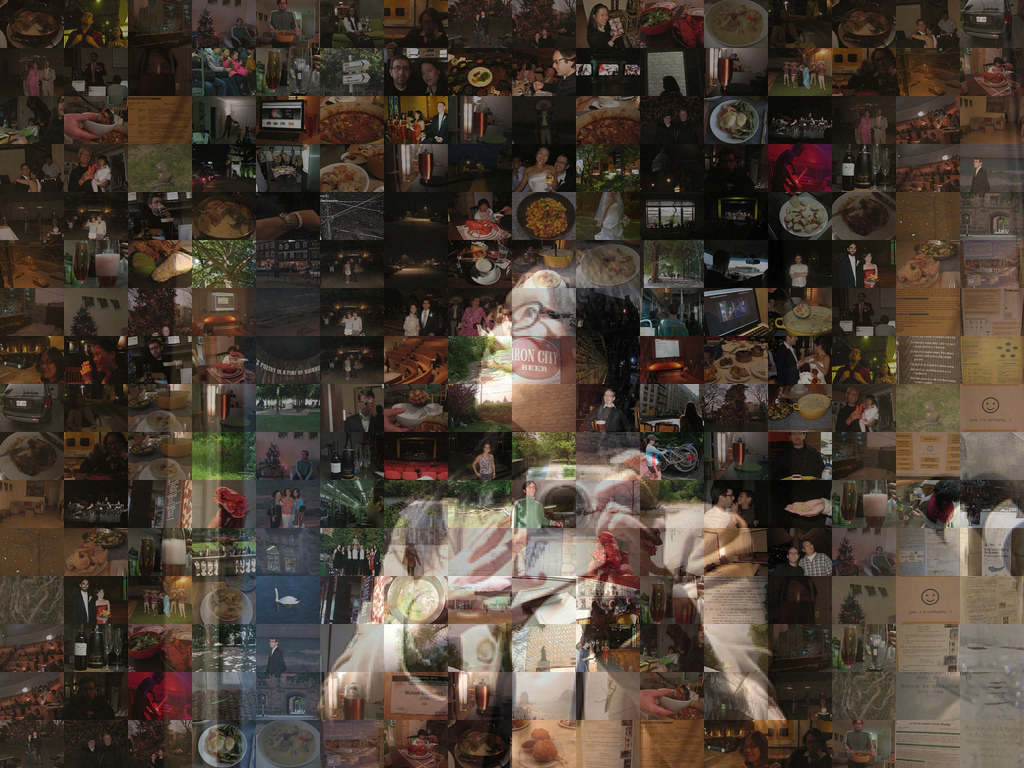(my wife as a composite of memories-constructing identity on the fly)
Much of this was inspired by Judy Brown’s presentation Future Mobile Learning as well as my own fascination with learning technology that adheres to the natural dimensions of human activity, that organically grows from human motion in general. Mobile learning is basically an embrace of the affordances of that type of motion, an understanding that perhaps humans learn better in situ, precisely when they are in commune with the object of learning. At the very least, it is an exploration of how the traditional models of education may or may not work to our advantage in a mobile context.
For me, the race is towards removing or mitigating those conscious gaps that exist between introducing an object of learning, experiencing that object, and then knowing that object. Traditional models have us conceptually learning of the object (text or classroom instruction), then experiencing the object (either through controlled experiments in laboratories, or in the other 75% of our day outside of class), and then knowing the object (through reflective practice and applied understanding-for me that is often this blog). Separating contextualizing, interacting, and knowing into stages may or may not be optimal and with mobile, they are certainly smudged together a bit. Either that, or the transition periods between the stages are instantaneous. I prefer to think of them as smudged.
Current mobile learning generally funnels its application through available mobile devices, such as iPhones, iPads, etc., but these ultimately seem like way stations towards melding technology to human activity. Signs of progress, for sure, and ones with enormous economic incentives (capitalizing on market demand for products dictates progress in future development), but ones that still require a cognitive break from the learning object in question in order to interact. I am standing at a corner of an old building and I want to learn about its history, so I consciously raise my device to the object and use augmented reality of some sort to learn more. This is better than what we have had to date (going to the library to learn more), but it still taxes a cognitive load on the learner. There is still a cognitive break in consciously choosing to engage with the device for the sake of learning. Hence this presentation and its reference to the following.
Augmented reality contact lenses. In and of themselves, they are not incredibly dramatic as we have had rear-projection capabilities for glasses for years (think fighter pilot displays), but what is exciting from a learning perspective is their continued mitigation of the cognitive dissonance between the stages of contextualizing, interacting, and knowing. All of these can be done with little to no lag, on the fly, on the spot, socially. This is where mobile becomes transformative. It transforms learning in a few dimensions:
Social
Thousands of social applications here and by social I mean accepted social practice. It places a premium on multitasking, in situ multitasking (searching through your contacts to find more information about a person you are talking to as they are talking-immediate context), promotes immediate reflection (audio dictation which then transfers to some centralized knowledge repository (even a blog would be sufficient)), and even allows for social interaction (why not embed your reflections in the place for others to literally see as they walk by). A running dialogue that deemphasizes social temporal location (being in the same place at the same time) and emphasizes local continuity (just being at the same place and seeing what others thought). These contact lenses allow all of this to happen instantaneously and that frees up a cognitive surplus. Cognitive power directed towards manipulating technology is reallocated for understanding and knowledge construction with or without technology. Places a premium on the social navigation of these new realities. Places a premium on balance of cognitive learning tasks, multitasking, expanding on multiple fronts simultaneously. Deemphasizes the serendipity of time/location proximity and maximizes chronological continuity over time. The history of a place as told through the narrative of our collective understanding of a place.
It also allows technology to become socially permissable and poses some great challenges/opportunities for instruction. Banning Facebook is one thing or even mobile phones, but how does one ban technology that is undetectable on sight? Why would you want to? It certainly places some pressure on a situated pedagogy of physical context (the classroom) in terms of information transmission (if this doesn’t transform the teacher away from an information provider and more towards a skillful faciltitator/enabler of knowledge construction, I don’t know what will). It augments collaborative knowledge construction, allowing students to instantaneously draw on additional sources of information while in the context of collaboration. Group project planning stages could be instantly checked for validity, accuracy, even scoping. Reflection can occur in context, brief, stoccato knowledge checks based on a continual appraisal of the learning to the context (as simple as Does this work? Does this answer our research question? Is this even doable?).
All of this from a contact lens. It isn’t science fiction, either. It is coming. Just want to stay ahead of the learning (theory) curve. Be sure to check out Judy’s presentation below, as well as take a look at some of the projects she references throughout including some of my favorites:




Reblogged this on digitalmediadiary and commented:
Add your thoughts here… (optional)